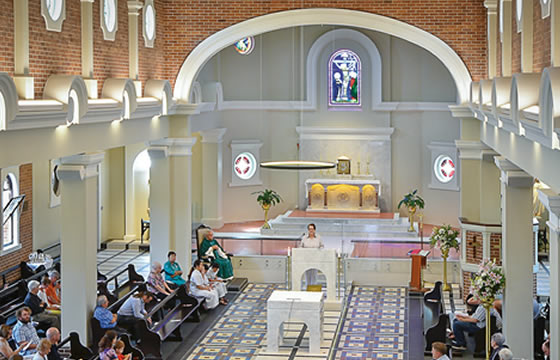 Australian churches have heritage values in need of protection.
Australian churches have heritage values in need of protection.
Harry Stephens would love a watershed moment within the Church when it comes to preserving Australia’s Catholic architecture. But he’ll settle for a shift in the right direction. Following Australia’s national Church Architecture Symposium, ‘Where your treasure is, there will your heart be also: Catholic Liturgical Heritage’, Harry’s confident the shift is happening.
The symposium in Melbourne, sponsored by the National Liturgical Architecture and Art Council (NLAAC) of the Australian Catholic Bishops Conference, Catholic Church Insurance, and the Australian Catholic University (ACU) Centre for Liturgy, captured the attention of several Bishops, architects, priests, religious and lay people.
Harry, who is Secretary of the NLAAC, an architect and one of the team of Symposium organisers, said the body of evidence presented by leading heritage scholars from around the world convinced participants of the importance of protecting the heritage values of Churches in Australia. ‘The notion of heritage is often scoffed at in Australia when compared with famous Catholic churches and cathedrals around the world. But we do have a large stock of very fine buildings and they need to be protected’, Harry said.
PRAISE FOR ST PATRICK'S
Sophie Andreae, the vice-chair of the Patrimony Committee of the Bishops Conference of England and Wales, was one of the keynote speakers. She praised St Patrick’s Cathedral in Melbourne, which she said had survived the type of reordering that many Catholic churches in Britain underwent in the 20th century – including some in the same architectural style.
In a report of the Symposium, published by the Australian Catholic Bishops Conference, Ms Andreae said: ‘many people reacted against Victorian architecture during the second half of the 20th century. That attitude, coupled with liturgical changes after the Second Vatican Council, “seemed to give some people a green light to rip out the interiors of churches”. That included the whitewashing of once-vibrant statues, the removal of some holy objects and what some now consider the hurried redesign of church sanctuaries. Now, decades later, a number of bishops and others are trying to recapture the beauty and colour of those churches and to see how the sense of the sacred can be restored.’
BEST AND WORST SHOWCASED
The Symposium showcased some examples of unsuccessful Australian reconstruction or restoration work. It also showcased some of the best contemporary Church building works, including Geraldton’s St Francis Xavier Cathedral and Sts Peter and Paul Parish Church, in Bulimba, Queensland. The workshops and lectures shone a light on many of the architectural pitfalls, commissioning religious art, redesigning confessionals, understanding liturgy, funding challenges and community engagement.
‘There are lots of stories of parish priests wanting to leave a legacy in their parish and they get drawings done and take it to the finance committee who tell the priest the building work can’t be funded,’ Harry said. ‘The laity need to play a greater role in what happens to their Church.’
To help preserve Australia’s Catholic architecture and heritage, the NLAAC released a new document, ‘Fit for Sacred Use’ – a set of liturgical and heritage principles to guide any work. ‘We would encourage Church communities to work together on restoration work using this document. Even if it is just modernising the sound and lighting, there are guidelines.’
DIGITAL CATALOGUE
A new digital catalogue of Church-owned items called, Cultura, was also launched at the Symposium. It is hoped that Catholic communities around Australia will use Cultura and do a ‘stocktake’ of their property, including everything from artworks and vestments to candleholders and chalices.
Harry, whose own recent design work includes a new altar at St Scholastica’s College in Glebe and a new baptismal font at Holy Spirit Church in Hobart’s Sandy Bay, encouraged priests and parishioners to catalogue their Church’s ‘treasures’ so that the history of a faith community was maintained and valued.
‘I am hopeful we are now heading in the right direction,’ he said.
Image: Sts Peter and Paul Parish Church, Bulimba, Queensland has been commended as one of the best contemporary Church building works. Parish priest Fr Tom Elich is seated left.
See also: Geraldton Church a tourist attraction